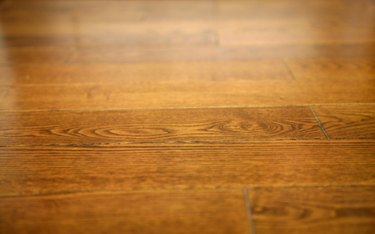
Floor installers in the past often used shellac or varnish as a finish. You can soften them by moistening them with a solvent like acetone, and strip them when they are soft, but doing so isn't the best way to do the job. Most contemporary floor installers use polyurethane instead of shellac. It hardens by curing and produces a much more durable coating, but because it cures, you can't soften it again by using acetone.
Shellac, Varnish and Polyurethane
Video of the Day
Shellac is a natural polymer originally derived from a resin secreted by lac bugs and dissolved in a solvent. Some varnishes are similar, consisting of a natural resin, usually pine sap, in a solvent. You can soften either of these with acetone. Polyurethane, although sometimes called a varnish, is a synthetic plastic. Although it too is borne in a solvent, which can be similar to the type that carry shellac or can simply be water, it undergoes a complex chemical reaction with the air as the solvent evaporates -- a process called curing. The reaction is irreversible, and polyurethane doesn't become soft again.
Video of the Day
Stripping a Floor With Acetone
Although you can strip a floor with acetone if it is finished with shellac or a similar material, like lacquer, most modern floor finishers don't use either of these materials as a final finish because they aren't hard enough. Acetone will soften some varnishes that were in common use before polyurethane became popular, making them marginally easier to scrape off, but the process is messy and time consuming. Even removing shellac or lacquer, which dissolve readily in acetone, is messy and labor intensive. It requires several applications of the solvent to do the job properly.
How to Remove a Finish
The best way to remove any floor finish, except wax, is by sanding. You can sand with a palm sander, but you'll spend less time and do a better job if you rent floor sanding tools from a local rental shop. The machines are weighted and remove the finish and a thin layer of wood at the same time. You can smooth the floor and restore the natural color of the wood with just two or three passes of the machine. If your floor has a coating of wax, clean it off with a wax-removing detergent before sanding.
Warning
If you strip a floor with acetone, you will not only work harder, but you'll leave streaks and other marks that you'll probably have to remove by sanding anyway. Acetone is a volatile and noxious solvent that can damage your nervous system if you breathe it for an extended period, and if you use it to strip an entire floor, there is a good chance that you or other people in the house will breathe enough to do harm. Moreover, acetone is extremely flammable, and you should never use it near an open flame or source of high heat.